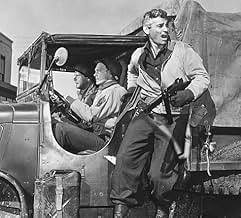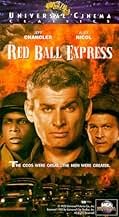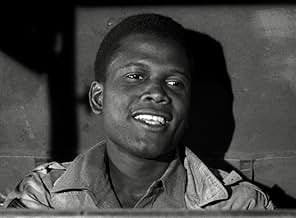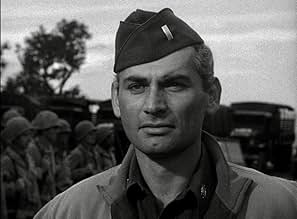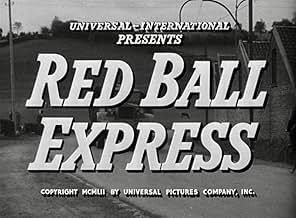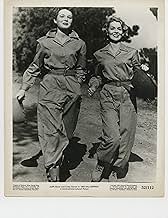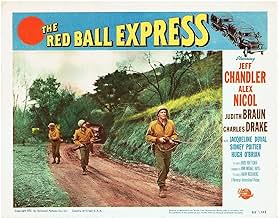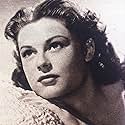CALIFICACIÓN DE IMDb
6.3/10
969
TU CALIFICACIÓN
Agrega una trama en tu idiomaStory of the military truck drivers who kept the Allied armies supplied in Europe during World War II.Story of the military truck drivers who kept the Allied armies supplied in Europe during World War II.Story of the military truck drivers who kept the Allied armies supplied in Europe during World War II.
Davis Roberts
- Pvt. Dave McCord
- (as Robert Davis)
Gregg Palmer
- Tank Lieutenant
- (as Palmer Lee)
Douglas Bank
- Mechanic
- (sin créditos)
George Barrows
- Soldier in Bistro
- (sin créditos)
Nan Boardman
- French Peasant Mother
- (sin créditos)
- Dirección
- Guionistas
- Todo el elenco y el equipo
- Producción, taquilla y más en IMDbPro
Argumento
¿Sabías que…?
- TriviaLouis L'Amour's memoir, "Education of a Wandering Man", said this movie was actually based on his own war-time anecdotes. He was awarded two Bronze Star Medals while serving as an officer with the Red Ball Express.
- ErroresThe real Red Ball Express operated two separate roads for traffic (one going to the front and one for returning empty) Two-way traffic on a single road, as shown in the film , never occurred.
- Créditos curiososNo credits besides the title, seven minutes in the film.
- ConexionesFeatured in Budd Boetticher: A Man Can Do That (2005)
Opinión destacada
The setup, in case you don't already know it, is this. The troops of the western Allies were bottle necked in Normandy, France, for the first month or so after the D-Day landings. The armies finally broke through the German defenses and Gen. George Patton's Third Army rapidly advanced across central and northern France. So rapidly that they outpaced their supply lines. The U.S. Army put together a truck convoy system to keep Patton's forces supplied and named it the Red Ball Express. Aside from managing to keep up with Patton's advance, the outfit is also noted for being one of the few integrated units in the U.S. armed forces at the time--I use the term "integrated" somewhat guardedly, since that usually meant white senior officers leading black junior officers and enlisted men, which is not what would first come to my mind as "integrated." Regardless, around 75% of the servicemen in the Red Ball Express were African Americans.
You wouldn't know that from this movie, where the ratio seems to have been reversed. However, I'm willing to give the filmmakers some credit for at least trying to address the integration issue at the time when they were working rather than castigate them for not doing what we might expect a present-moment filmmaker to do. That's not the real problem with this movie as a movie. Acting is not the problem with this movie, either, as another reviewer suggested. The acting is workmanlike--neither outstanding nor poor, just efficient. No, the weakness of this movie is that it is simply another cliché-ridden war movie; blame not the messengers, but rather the script. First, there is the clichéd unit. Our two lead characters have a troubled past and, surprise surprise, are forced to work together in the same outfit ("of all the gin joints in all the towns . .."). The unit has a romantic, it has a "runt" of the litter with glasses, it has a stolid misunderstood commander, it has a guy clearly from Brooklyn, and so forth. Just like any other war movie of the day (think of, say, "Air Force" or "Guadalcanal Diary"). What's new here for the time is that the filmmakers exchanged African Americans for some of the other stereotypical roster of "average Americans" you got in any war movie. Notably, there are NO characters who are clearly supposed to be white Southerners--an omission that itself speaks volumes about how sensitive race relations were in the early 1950s in the U.S. and especially in the then-recently desegregated U.S. armed forces.
The clichéd unit is indicative of the rest of the flick. You've seen this movie before. Bunch of misfits forced to work together overcome their differences and become a cohesive fighting unit--well, except here I never really got the sense we were watching an outfit of misfits. Yes, there's the guy with the racial issue vs. Sidney Poitier, and yes, there's the lead characters with the troubled past--one of whom is the main stumbling block that's keeping this outfit from fully coming together (what's that you say? That setup sounds like "Flying Tigers"? no wait, "Sands of Iwo Jima"? no, wait . . .)--but the movie is in too much of hurry to get this outfit on the road to really *show* how this outfit becomes a team. Essentially it just is. What else, you ask? How about the sweet-talking American and the saucy French girl? Rivalry with another outfit, with other outfit finally recognizing our heroes are indeed Heroes? The guys who think there mission is going to be a cakewalk only to discover the Harsh Reality Of War? Etc., etc.
Oh, the movie is solid enough and hits all the standard points--some action, some down time, some roughhousing, a romantic moment or two, some grousing, some "let's pull together" time--and some of the cast members are likable enough that, all told, you won't feel like you wasted your time watching this one. However, aside from the then-timely touch of trying to show an integrated outfit there's nothing here to see you haven't seen before.
You wouldn't know that from this movie, where the ratio seems to have been reversed. However, I'm willing to give the filmmakers some credit for at least trying to address the integration issue at the time when they were working rather than castigate them for not doing what we might expect a present-moment filmmaker to do. That's not the real problem with this movie as a movie. Acting is not the problem with this movie, either, as another reviewer suggested. The acting is workmanlike--neither outstanding nor poor, just efficient. No, the weakness of this movie is that it is simply another cliché-ridden war movie; blame not the messengers, but rather the script. First, there is the clichéd unit. Our two lead characters have a troubled past and, surprise surprise, are forced to work together in the same outfit ("of all the gin joints in all the towns . .."). The unit has a romantic, it has a "runt" of the litter with glasses, it has a stolid misunderstood commander, it has a guy clearly from Brooklyn, and so forth. Just like any other war movie of the day (think of, say, "Air Force" or "Guadalcanal Diary"). What's new here for the time is that the filmmakers exchanged African Americans for some of the other stereotypical roster of "average Americans" you got in any war movie. Notably, there are NO characters who are clearly supposed to be white Southerners--an omission that itself speaks volumes about how sensitive race relations were in the early 1950s in the U.S. and especially in the then-recently desegregated U.S. armed forces.
The clichéd unit is indicative of the rest of the flick. You've seen this movie before. Bunch of misfits forced to work together overcome their differences and become a cohesive fighting unit--well, except here I never really got the sense we were watching an outfit of misfits. Yes, there's the guy with the racial issue vs. Sidney Poitier, and yes, there's the lead characters with the troubled past--one of whom is the main stumbling block that's keeping this outfit from fully coming together (what's that you say? That setup sounds like "Flying Tigers"? no wait, "Sands of Iwo Jima"? no, wait . . .)--but the movie is in too much of hurry to get this outfit on the road to really *show* how this outfit becomes a team. Essentially it just is. What else, you ask? How about the sweet-talking American and the saucy French girl? Rivalry with another outfit, with other outfit finally recognizing our heroes are indeed Heroes? The guys who think there mission is going to be a cakewalk only to discover the Harsh Reality Of War? Etc., etc.
Oh, the movie is solid enough and hits all the standard points--some action, some down time, some roughhousing, a romantic moment or two, some grousing, some "let's pull together" time--and some of the cast members are likable enough that, all told, you won't feel like you wasted your time watching this one. However, aside from the then-timely touch of trying to show an integrated outfit there's nothing here to see you haven't seen before.
- Carl-17
- 8 sep 2010
- Enlace permanente
Selecciones populares
Inicia sesión para calificar y agrega a la lista de videos para obtener recomendaciones personalizadas
- How long is Red Ball Express?Con tecnología de Alexa
Detalles
- Fecha de lanzamiento
- País de origen
- Idiomas
- También se conoce como
- Red Ball Express
- Locaciones de filmación
- Productora
- Ver más créditos de la compañía en IMDbPro
- Tiempo de ejecución1 hora 23 minutos
- Color
- Relación de aspecto
- 1.37 : 1
Contribuir a esta página
Sugiere una edición o agrega el contenido que falta

Principales brechas de datos
By what name was Hermanos ante el peligro (1952) officially released in India in English?
Responda
